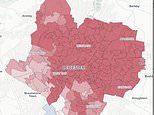

The ethnic make-up of England and Wales can be shown in unparalleled detail today through the lens of MailOnline’s street-by-street breakdown.
Using the most up-to-date ethnicity statistics derived from the Census, MailOnline analysed the rate of white Britons living in all 35,000-plus LSOAs (local areas used to group statistical data) across England and Wales.
These neighbourhoods, consisting of between 1,000 and 3,000 people, provide astonishingly detailed insights into pockets of the country.
The full results of our investigation are available to explore in our interactive map, below. The darker the shade of blue, the higher the proportion of white Britons.
To find your immediate area, select your local authority from the drop-down list and zoom into wherever you want to search.
All of the pop-ups are named by the electoral ward, meaning neighbouring areas may appear with the same name but have different statistics. That is because each ward may have numerous LSOAs.
Within Redcar and Cleveland, for example, there are five instances of Brotton, as the LSOAs go across the electoral ward.
In one district, technically called Redcar and Cleveland 010B, in Middlesborough, all but two residents identified as ‘white British’. This equated to a rate of 99.8 per cent, which was the highest in the country.
Fourteen LSOAs in total had a white British population that exceeded 99 per cent.
With the exception of one in Newcastle-under-Lyme, Staffordshire, and another in Caerphilly, Wales, the rest were scattered across the North.
When looking at local authorities as a whole, the North Devon council of Torridge had the highest percentage of white British residents.
There, 35 of the 38 LSOAs were over 95 per cent white British. The other three neighbourhoods had a proportion between 93 and 94.3 per cent.
Anglesey, Redcar and Cleveland, Copeland in Cumbria, and the Staffordshire Moorlands rounded out the top five, in terms of the proportion of LSOAs where at least 95 per cent of residents identified as white British.
On the other hand, Medway, in Kent, had the lowest rate – just one of its 169 areas tipped the threshold.
Across England and Wales, 6,000 LSOAs have a minority white British neighbourhood.
These range from the affluent Hampstead Heath area of Camden (49.9 per cent) all the way through to Wycliffe in Leicester, where just 0.2 per cent of the population is white British. In that suburb of Leicester, a mile from the city centre, there were only three White Brits.
At authority level, there are 32 – including Luton and Slough – where white Britons are already a minority.
Barking and Dagenham has seen the biggest decline, going from 80.9 per cent in 2001 to 30.9 per cent in 2021.
MailOnline’s analysis comes as one of Britain’s leading demographers claimed that white Britons will be a minority in 25 years if the pace of immigration continues.
David Coleman, emeritus professor of demography at Oxford University, predicts the proportion across the UK will dip below 50 per cent in 2053.
Sharing his eye-opening projections with MailOnline, he said: ‘If this pace of cultural and ethnic change continues then the consequences are going to be very, very negative.’
In six authorities, including Barking and Dagenham in east London, the share of white Britons has more than halved since 2000, our investigation showed.
Across the UK, white Britons – residents who identify as either English, Scottish, Welsh, Northern Irish or British – made up 74 per cent of the total population in the 2021 Census. This is down from 88 per cent in 2021, when officials began tracking comparative data.
Professor Coleman, an ex-Home Office adviser, previously forecast white Britons would cease being the majority by 2066.
Writing for the Daily Mail in 2015, he claimed that ‘date would move closer to the present’ should immigration levels persist. When that point is reached, Professor Coleman stated Britain would ‘become unrecognisable to its present inhabitants’.
Despite his expertise, the academic – once described by colleagues as the ‘best’ in his field – has come under fire for co-founding Migration Watch.
Oxford students petitioned to have him sacked because of his links to the immigration think tank, which has been accused of peddling ‘racist rhetoric’ by shining a light on the contentious topic. The Guardian once also dug into Professor Coleman’s role in the Galton Institute, formerly the Eugenics Education Society, interpreting his support of immigration controls as inherent racism.
Professor Coleman, in response to our analysis, said: ‘People blame immigrants for all sorts of problems, despite the real fault and blame lying at the door of the Government.’
Similar forecasts made by Professor Matt Goodwin, a political scientist at the University of Buckingham, based on migration, birth and death rates this week suggested white Britons will no longer be the majority come 2063.
Predicting that six in 10 people in the UK will either not have been born here or have at least one immigrant parent by 2100, Professor Goodwin argued his research raised ‘profound questions about the capacity of the UK state to both absorb and manage this scale of demographic change’.
Our analysis comes after Keir Starmer last month warned that mass immigration risked making the UK an ‘island of strangers’, in a hardline critique which drew comparisons to Enoch Powell’s notorious ‘Rivers of Blood’ speech.
The Prime Minister promised to deliver Britons what they had ‘asked for time and time again’ as he unveiled a package to ‘take back control of our borders’, which includes hiking the skills threshold and toughening rules on being fluent in English. Officials estimate it will drive down annual inflows by around 100,000.
MailOnline analysis shows the figure has fallen in all 169 councils across England and Wales for which full datasets are available. Boundary changes mean not every authority can be measured over time.
Because the data was taken before immigration spiralled to record highs, the reality in 2025 could be even starker.
Since 2018, for example, nearly 165,000 migrants have crossed the English Channel in small, boats. Hundreds have died trying.
Despite Sir Keir’s promise to ‘smash the gangs’ who orchestrate the crossings, more than 30,000 migrants have now arrived in Britain by small boat under his tenure – the most of any other year on record.
David Goodhart, head of the immigration and integration unit of think tank Policy Exchange, told MailOnline: ‘In Britain, we’ve been living through an extraordinary experiment.
‘It’s very hard to talk about the decline in the white British population since the millenium. The proportion of people who feel uncomfortable about it is probably the majority but we just don’t know how to talk about it – most of the conversation is just hand-wringing.
‘We have a very strong taboo against racism and it is very easy to characterise commenting on rapid ethnic change as racist.’
In the year to June 2023, the ONS said 1.32million people immigrated here, mainly from India, Nigeria, Pakistan, China and Zimbabwe. Another 414,000 emigrated.
It meant around 906,000 people – the equivalent to two Leicester-sized cities – settled in Britain.
That excludes natural changes to the population, with births outnumbering deaths and only adding to the strain of Britain’s public services.
Despite the eye-watering numbers, evidence suggests the British public are not as concerned about it as is often claimed. Immigration was considered the fourth most important topic to voters in the run-up to last year’s general election, behind the cost of living crisis, health and the economy.
Recent research from integration think tank British Future found a whopping 45 per cent of the British public wouldn’t reduce immigration if given the choice.
According to Oxford University’s Migration Observatory, the most common reason given by migrants for moving to the UK in 2022 was family (37 per cent), followed by work (29 per cent) and study (14 per cent).
Indeed those who come here in search for work tend to be more successful in doing so than native Britons.
Research from 2022 shows that working-age migrant men were more likely to be in employment (82 per cent) than UK-born men of similar age (78 per cent).
Migrant workers are also seen to be a net positive to the UK economy throughout the course of a lifetime.
The Office for Budget Responsibility projects that a 25-year-old migrant arriving and earning the UK average wage has a more positive lifetime impact on the economy than a UK-born worker. This is down to the state not providing education or health funding in their first stretch of life.
Soaring immigration comes as the birth rate lags at an all-time low. Women in England and Wales, on average, now only have 1.44 children.
The trend has spooked experts, triggering warnings that a population collapse is imminent and the UK will have to rely on immigration to offset low birth rates.
If the downward spiral continues, it may leave Britain with too few young people to work, pay tax and look after the elderly. This would pile even more pressure on the NHS and social care systems and hamper economic growth.
Yet becoming reliant on immigration to offset low birth rates would only fuel the fire on what is already a insanely controversial topic in British society.
Professor Coleman said: ‘In terms of population growth, we may be entirely overwhelmed with the effects of low birth rates already.
‘In the past it has been supposed that migration increases the birth rate, but now demand for housing is so high, it pushes prices up that it compresses down the rate babies are born – when house prices are nine times the average income, it must be having an effect of the birth rate.’
He also notes a significant problem when talking about the relationship between migrants and birth rates ‘en bloc’.
In his opinion, some cultures, such as the Chinese and Indian, ‘integrate and mix very well and cause no problems at all’. But Professor Coleman argued this isn’t the case for all backgrounds, especially those who don’t typically marry ‘outside of their narrow clan’.
He told MailOnline: ‘It is not the responsibility of a country to assimilate immigrants, the onus is on them.
‘Many of them, particularly Muslims and those from South East Asia don’t see an obligation to do so.
‘The real failure is on us to not make any conditions about what they should have to do on arrival to mix properly.’
A Policy Exchange report, co-authored by Professor Goodhart, named Whatever happened to integration?, describes a ‘pessimistic’ but ‘all too plausible’ scenario that Britain becomes increasingly diverse on a national level, but remaining segregated on a local one.
Professor Goodhart’s contention is as a society Britain is more divided due to its diversity and integration isn’t happening as much as it should.
He said: ‘Millions and millions of people in Britain would not pass the “bus stop test”‘ – the idea of telling a stranger at a bus stop a joke about contemporary life.
‘But in liberal societies it is very, very difficult to require people to integrate. We are not Singapore, which requires pretty authoritarian policies which no British government would entertain.’
Mr Goodhart’s answer to increasing integration is a ‘far more restrictionist’ immigration policy, particularly focused on those who are ‘very culturally different’ to people in the UK.
In terms of integration, data shows that to be culturally British is now seen as far more important than ethnically British.
In 2013 the National Centre for Social Research found that 74 per cent of Britons thought it was important to be born in Britain to be ‘truly British’. Last year that number had fallen to 55 per cent.
Similarly, the proportion who believe it is important for someone to have British ancestry dropped from 51 per cent to 39 per cent in 11 years.
In the research conducted by renowned election pollster Sir John Curtice, the public has grown to see respect for the country’s laws as the most important factor in British life.
Marley Morris, an associate director at the Institute for Public Policy Research, told MailOnline people are far more relaxed about the changing look and feel of their communities than they seem, but tensions are still high on hot-button issues, made more complicated by flawed Government messaging.
He said: ‘The increasingly liberal attitudes towards migration have shifted recently as there’s been more focus on the small boats issue.’
To separate immigration as a whole from these crossings and encourage more integration, Mr Morris holds the government accountable.
Mr Morris added: ‘There are significant tensions, racist and inflammatory attacks and language targeted at different communities so integration hasn’t been a focal point.
‘It’s a debate where people with concerns feel like they’re being shut down on the whole topic of immigration so we need to be able to hear them and get the right tone and Government leadership here is very important.’
Sunder Katwala, director of British Future, said the public is already more accepting than many voices on the topic may suggest.
He said: ‘British identity holds up even though the white population gets smaller but it depends on if white Britons think non white Britons are British as well.
‘The number who don’t feel that way are a very small group – only 3 per cent would say Rishi Sunak or Kemi Badenoch are not British.
‘The reason there’s been a big collapse in those who want white British identity only is because across the country there’s a lot more contact among widespread ethnic groups at young ages, so it’s now much more accepted.’
Mr Katwala added that in this respect, Britain is a ‘generation ahead’ of fellow Western powers like Germany and France.
But not everyone sees it that way and the issue has become more complex through the emergence of Reform, now considered Labour’s de facto opposition, Mr Katwala said.
On the first page of Nigel Farage’s party’s ‘contract’ to the public, it says: ‘Record mass immigration has damaged our country… Multiculturalism has imported separate communities that reject our way of life.’
Mr Katwala added: ‘Mr Farage has always said he’s not the BNP and not Tommy Robinson – you can’t have a mainstream populist party if it lets people with a racist argument in.
‘He’s appealing to the people worried about the pace of integration but it’s quite often the case that racists might join his party because they think it’s the closest they’re going to get.’
Even in the eventuality that the small boats crisis and immigration levels are brought under control to more manageable levels, the rhetoric around living in Britain and being British is likely to continue to be divisive.
The recent Government white paper on immigration is looking to simultaneously reduce numbers and promote higher standards of various measures of integration.
The route to citizenship will double from five to ten years, bringing families across will likely become more difficult and higher skill thresholds will be required across multiple sectors fed by migrant workers such as healthcare.
There will also be an increased focus on English language proficiency and civic integration, with a review of the Life in the UK test.





